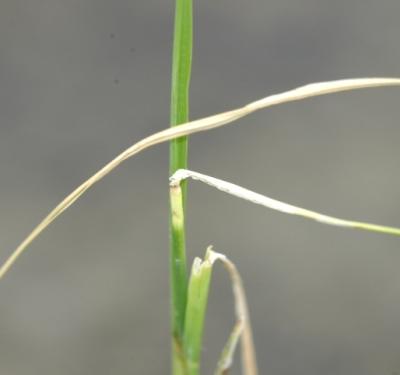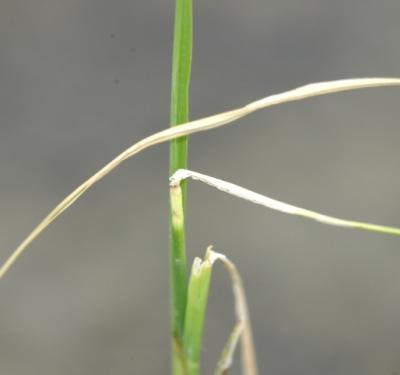

Rice whorl maggots (rice leafminers) (Hydrellia spp.)
The rice whorl maggot (Hydrellia prosternalis) has been reported from West Africa. Another species Hydrellia sp. has been reported in Kenya (NIB, 1995). Adults of the rice whorl maggot and rice leafminers are small flies (1.5 to 3 mm long), grey to black in colour with silvery white or golden brown markings on the lower part of the head. They lay white cigar-shaped eggs on the leaves. Upon hatching the maggots of the leafminers penetrate the leaf tissue and feed in between the 2 layers of the leaf causing mines parallel to the veins. Maggots may pupate in an existing mine or migrate to a different leaf to form a new mine. High humidity (80-100% relative humidity) is required for leafminer development, therefore, mines are typically observed in leaves close or lying on the water surface. Whorl maggots start feeding on the leaf margins causing large scarred areas giving the leaf a ragged appearance and causing eventual leaf collapse. Eventually the maggots enter the whorl and tunnel the plant's developing stem.
Feeding damage by leafminers retards plant development, reduces plant vigour and renders infested plants less competitive with weeds. Plant vigour and weather conditions affect the extent and seriousness of the damage caused by the rice leafminer. Damage extent is closely related to the speed the plant growths erect and out of the water. Any factor affecting plant growth, which increases the number of leaves remaining lying on the water, or the length of time they are fully in contact with water will increase damage. The plant is usually able to produce additional leaves, but continued mining can result in reduced tillering, greater susceptibility to later pest attack, delayed maturity, or death of the plant. Once leaves start growing upright above the water, the rice leafminer does not cause economic damage. Attack by the whorl maggot may kill young plants (2 to 6 weeks after emergence) depending on the severity of the damage. Plants that survived damage are eventually drowned by the flood, or plant stands get so thinned that are easily overwhelmed by weeds.
Other leaf-mining fly (Creodont orbiting) has been reported as a minor pest in West Africa. This leaf-mining fly is widely spread in the rice-growing region in Ghana, but it is of no apparent economic importance. The adult is a small fly (about 1.6 mm long). Females lay eggs into the leaf tissue, and the maggots feed forming mines towards the leaf tip. Maggots pupate within the mines. Symptoms of damage are the transparent, light brown mines that are elongated along one side of the midrib reaching up to 6 cm in length.
- The rice leafminer can be controlled by managing the water level.
- Avoid leaf contact with water. However, this practice seems to intensify the whorl maggot problem. Field observations in Louisiana, USA showed that by draining fields, the maggot enters the plant whorl and stems without being drowned (LSU AgCenter).
- Drain the water at intervals of 3 to 4 days during the first 30 days after transplanting to reduce egg laying as the adult flies are more attracted to standing water.
- To reduce the potential for damage by the rice leafminer encourage the rice to emerge quickly and grow erect.
- Level the field as accurately as possible and start the crop in 7-10 cm of water. Increase the water depth slowly after the leaves begin to grow upright.
- Monitor for rice leafminers to determine the need to lower the water level. Begin monitoring two to four weeks after planting, just after most of the rice plants have emerged from beneath the water and the leaves are lying on the water surface (UC Pest Management Guidelines).
- Crop establishment methods that enable the plants to cover the water surface most rapidly usually result in insignificant damage.Thus, close planting has been shown to decrease egg laying and subsequent damage by leafminers in several countries in Asia and South America.
